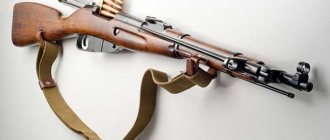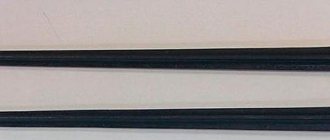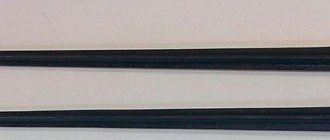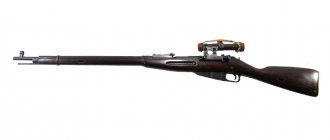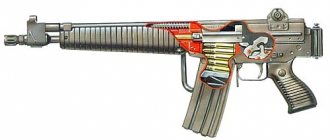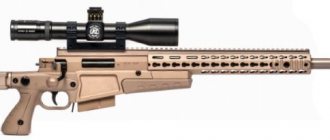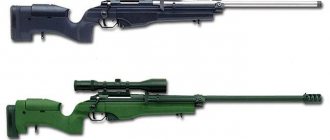History of the exhibit
Mosin rifle manufactured in 1941, produced in Izhevsk shortly before the start of the war. This is evidenced by the quality of surface treatment. She was captured in Finland, perhaps in the same year of 1941, from where, apparently, she did not return during the fighting, but only in the form of a model in our time.
Has two marks of the Finnish arsenal - “SA”. The mark was applied from 1942 and after the war.
You may also be interested. 7.92 mm carbine “Karabiner 98 kurz” (Kar.98k or K98k) 1940
The rifle probably served its owners well: 10 mm of the barrel on the muzzle side is drilled out - this is a sign of wear. This operation was intended to restore the accuracy of the battle.
During the second arsenal repair, all parts were disassembled and reassembled from different rifles, also a common practice for Finnish arsenals. 99% of Suomi submachine guns are also assembled from various spare parts.
However, all the parts found on the weapon fit the 1941 period, and specifically the stock with the early edges of the slits for the belt has screws. The pickguard has brass edging. Then, in 1941, these elements were simplified.
It is noteworthy that on this stock there are preserved unwashed remains of the winter color, and the initials of the owner “HV”. Also noteworthy is the non-standard hole for draining water from under the barrel in the lower part of the stock.
The front sight was replaced with an open Finnish one, with a spacer to increase the height. There are no more upgrades.
The overall condition of the item, the absence of polishing and late parts makes the rifle a desirable exhibit in the collection. The rifle has retained the imprint of time, as if it had been stolen from a Finnish soldier’s trench.
A little bit of Wiki
The Russian 3-line (7.62 mm) Mosin rifle model 1891 is a repeating rifle adopted by the Russian Imperial Army in 1891. Had other names - 7.62 mm rifle mod. 1891 (1891/30), three-ruler, Mosin rifle, “Mosinka” and the like. Widely used from 1892 to the end of the 1950s. (in the PLA and KPA), during this period it was modernized many times. The name three-line comes from the caliber of the rifle's barrel, which is equal to three lines (an obsolete length measure equal to one-tenth of an inch or 2.54 mm). Based on the 1891 model rifle and its modifications, a number of models of sporting and hunting weapons, both rifled and smooth-bore, were created.
Trunk
The barrel has a variable cross-section on the outer surface, decreasing towards the muzzle, and has protrusions in the muzzle and breech parts, which are respectively the bases for the front sight with the front sight and the sighting block. On the hemp, the breech of the barrel, a thread is cut, onto which the receiver is screwed with an interference fit. The rifled part of the bore has four grooves, curving from left to top to right.
Receiver
The receiver is made massive to obtain the required rigidity. Inside, along its entire length there is a channel for placing the bolt, which has longitudinal grooves in the vertical plane for the combat lugs of the combat cylinder, and in the front part there is a thread for connecting to the barrel and an annular groove for placing the lugs when the barrel channel is locked. In the middle of the receiver there are upper and lower windows. The right wall of the upper window is cut to accommodate the ridge of the bolt stem, and grooves are formed on the rear for inserting a clip when filling the magazine box. On the left side of the receiver there is a slot with a threaded hole for a cut-off reflector. In the rear part there is a longitudinal groove on top for guiding the ridges of the bolt stem and trigger, and at the bottom there is a window for the passage of the sear of the trigger lever and the trigger head. To connect the receiver with the stock, trigger mechanism and magazine box, there are threaded holes for the tail rotor and the stop screw; in the rear part there is a boss for securing the trigger axis.
Rifle bolt
The rifle's bolt is a bolt-action type that rotates when locked. The bolt with the mechanisms assembled on it performs the following functions: sending a cartridge into the chamber, locking the bore, firing a shot, removing the spent cartridge case, interacting with the cut-off reflector. It consists of a bolt stem, a combat cylinder, an ejector, a trigger, a firing pin, a mainspring and a connecting strip.
Impact mechanism
Striker-type impact mechanism. The mainspring has 28 turns.
Safety mechanism
The safety mechanism is implemented in the bolt and provides protection against the possibility of a shot when chambering the next cartridge and against the possibility of premature shots. When unlocking the barrel bore, the edge of the screw cutout of the bolt stem, acting on the surface of the screw protrusion of the trigger, moves it back, since the trigger ridge, guided by the groove of the receiver, will not allow the trigger to turn along with the stem. In this case, the mainspring, whose front end rests against the rim of the firing pin, and the rear end against the ledge of the channel in the bolt stem, will receive preliminary compression, and the firing pin will disappear into the channel of the combat cylinder. Retraction of the hammer with the hammer continues until the screw protrusion of the hammer comes out of interaction with the screw cutout of the stem, and when the barrel bore is unlocked, the end of the screw protrusion jumps into the socket on the bolt stem, which fixes the position of the hammer with the hammer in relation to the bolt stem at reloading a rifle.
When the bolt moves forward during reloading, the hammer cocking moves behind the sear of the trigger lever. The combat cocking keeps the hammer and firing pin from moving forward, while the end of the screw protrusion of the hammer comes out of the socket on the bolt stem, and the mainspring receives final compression. When the barrel is locked, the screw protrusion of the trigger is installed against the deepest part of the screw cutout on the bolt stem.
To set the hammer to the safety cock, it is necessary to cock the firing pin, placing the hammer on the combat cock, lock the barrel, and then pull the hammer back, turn to the left and release. When the trigger is pulled back, the combat cock of the latter comes out of the fork of the connecting bar, and when turned to the left, it fits into the recess of the receiver. The safety protrusion of the hammer comb will then fit into the recess on the rear section of the bolt stem, and the edge of the comb will rest against the left wall of the receiver. In this position, the possibility of releasing the trigger with the striker, as well as the possibility of opening the bolt, is completely eliminated.
Trigger
Trigger without warning. It consists of a trigger, a trigger spring, a trigger spring screw, and a trigger shaft. The trigger is mounted on an axis between the ears of the receiver and consists of a head with a bolt stop and a tail. A rectangular hole is formed in the trigger head with chamfers applied on the upper edges, into which a trigger spring enters, attached with a screw to the wall of the receiver by the heel. At the rear end of the trigger spring there is a sear and a stop that limits the upward movement of the sear.
Cut-off reflector
The reflector cut-off is used for:
- restrictions on the movement of the clip inside the receiver when filling the magazine box with cartridges;
- holding together with the protrusion on the right wall of the receiver of the cartridge in the receiver:
- direction of the cartridge as it moves from the receiver to the chamber;
- cutting off cartridges in the magazine box when the bolt is open;
- reflections of a spent cartridge case.
Extraction of the spent cartridge case is carried out by an ejector, the hook of which, when the barrel is locked, jumps over the rim of the cartridge case. When the channel is unlocked, the ejector pushes the cartridge case out of the chamber to the extent that the combat cylinder moves back by approximately 6 mm, which facilitates further extraction. When the bolt moves backward, the reflective protrusion of the cutoff-reflector blade, passing in the longitudinal groove of the combat cylinder, will rest against the head of the cartridge case, and the latter will be thrown out of the receiver to the right and slightly upward.
Shop
The magazine is in the middle, located in front of the trigger guard and is integral with the latter. Vertical magazine box with single-row arrangement of cartridges. The magazine holds 4 rounds, the fifth goes into the barrel.
Feeder
The feed mechanism is secured with a pin on the lid of the magazine box. It consists of a feeder, a feeder spring, a feeder arm, a feeder arm spring, two pins and a screw.
Sighting device
The sighting device consists of a sight and a front sight. The sight is sectoral and consists of an aiming block, a sighting bar, a sighting bar clamp, two clamp latches, two latch springs, a sighting bar axis, a sighting bar spring and a sighting block screw. At the rear end of the bar there is a mane with a semi-oval slot for aiming. On the outer side of the bar there are divisions from 1 to 20 (in hundreds of meters): even on the right side, odd on the left; Between the divisions there is a dash for installing a sight up to 50 m. On the sides of the bar there are cutouts for the teeth of the clamp latches.
Three-line rifle workshop
There are weapons that appeared a long time ago and will not disappear soon. He is disliked by beginners and respected by professionals. It's hard to shoot and easy to hit. It is equally reliable in the mountains and jungles, in the snow and deserts. A weapon that does not age. This weapon is a repeating rifle.
At the end of the last century, many types of rifles appeared - each power armed itself with its own national system. As time passed, models of hunting and sporting weapons appeared on their basis, while the army models themselves were replaced by more modern automatic designs. After a hundred years, very few “magazines” remained in combat use, successfully designed and proving to be irreplaceable. Among them is a Russian three-line rifle. It is appreciated by those who attack and those who defend. It is kept in collections of weapons rarities. It is available for free sale. Finally, these weapons are used in small quantities by special forces for particularly precise work. And for this reason alone, it’s worth getting to know the three-line rifle better.
Its official name is the Mosin-Nagant rifle model 1891. But in the actual design of the weapon, only the name of this undeniably talented gunsmith remained from Nagan. His very successful mathematical layout and balance calculation was brilliantly translated into metal by the Russian artillery officer S.I. Mosin.
Captain Mosin set himself the task of creating a weapon for practical use in the most difficult conditions of various climatic zones of the Russian Empire, capable of withstanding barbaric exploitation in the mud of the trenches and insensitive to the sand that constantly falls from top to bottom in war. Captain Mosin reached his goal. He incorporated into his rifle conceptually new principles of operation of parts, assemblies and mechanisms. The metric profile of weapon parts and the system of their interaction were carefully thought out, tested in the most severe conditions, and only based on the test results, the only correct design decisions were made. A fundamentally new part, a cut-off reflector, was introduced into the design of the rifle, making the system virtually fail-safe. There were no unnecessary parts in this weapon. The rifle did not break - there was nothing to break in it. Moreover, it was easy to disassemble and assemble, which was very important when it was mastered by young soldiers recruited from the semi-literate peasantry of the then Russia.
The system submitted to the weapons competition in 1891 was not a Nagant rifle. It was a Mosin rifle.
The caliber of this rifle was measured in the old inch system and was equal to three lines (1 line is equal to 2.54 mm). And therefore, despite the official names of modifications of various times of release for the Russian population, it remained a three-line rifle. It has been called that way for over a hundred years.
The operating principle of this weapon is based on the operation of a rotary bolt sliding longitudinally in the receiver 11 (photo 16). When the bolt is sent forward, it picks up the cartridge from the magazine box 6 (photo 16), pushes it beyond the influence of the cut-off reflector 8 (photo 21), which prevents the cartridge from “falling out” vertically upward (photo 25), and along the guide grooves of the barrel box feeds the cartridge into the chamber. When the bolt handle is turned to the right, the combat lugs of the combat cylinder 3 (photo 18) rotate 90 degrees and extend beyond the combat lugs of the receiver (arrow A in photo 19). Thus, the system is locked (diagram 1.3). When you press the trigger (arrow E in photo 15), the sear (arrow D in photo 15) is lowered, from which trigger 1 is released (photo 5,6). Drummer 5 (photo breaks the capsule, a shot occurs.
When the bolt is sent forward, it picks up the cartridge from the magazine box 6 (photo 16), pushes it beyond the influence of the cut-off reflector 8 (photo 21), which prevents the cartridge from “falling out” vertically upward (photo 25), and along the guide grooves of the barrel box feeds the cartridge into the chamber. When the bolt handle is turned to the right, the combat lugs of the combat cylinder 3 (photo 18) rotate 90 degrees and extend beyond the combat lugs of the receiver (arrow A in photo 19). Thus, the system is locked (diagram 1.3). When you press the trigger (arrow E in photo 15), the sear (arrow D in photo 15) is lowered, from which trigger 1 is released (photo 5,6). Drummer 5 (photo breaks the capsule, a shot occurs.
When the bolt handle is turned upward, the lugs of the cylinder head and the receiver disengage from each other, the system is unlocked, and the hammer is cocked by the interaction of its helical worm geometry with the similar helical geometry of the end of the bolt stem 2 (arrow G in photo 9). Thus, the hammer of the open bolt will always be cocked. When the bolt is pulled back, the ejector hook, pressed into the combat cylinder, removes the spent cartridge case from the chamber. The geometry of the open shutter forms a groove-groove (arrow A in photo 20), with which the shutter, when moving backward, slides along the cut-off holder tooth (photo 21). The removed cartridge “runs into this tooth, is reflected from it and is thrown out towards the hook.
To load the weapon, you need to open the bolt, insert a clip loaded with five cartridges into the special grooves of the receiver (arrow B in photo 13) (diagram 2, photo 32), pressing the upper cartridge near the clip, squeeze all five cartridges into the magazine box in one motion, down all the way. Then close the shutter. That's all. The rifle is ready to fire. After firing, open the bolt back all the way, close it again, and shoot again. And so on five times. You can also shoot “one at a time” by placing cartridges directly into the chamber. By the way, craftsmen do this to avoid changes in the weight of the weapon, which affects the trajectory of the bullet when shooting at long distances. The rifle is extremely simple to use.
Now about the subtleties of the design that make it extremely reliable. Three-line rifle cartridges have a rim that ensures the ejector engages the cartridge case. In addition, sleeves of this shape are not “rubbed” by sand in the mechanism. But in turn, this edge, during the longitudinal movement of the cartridge along the mechanism, “catches” everything in its path, including the edges of other cartridges. Because of this, in the Nagan system rifle, two cartridges were often fed into the barrel at once and both jammed each other. Mosin eliminated this unpleasant phenomenon by introducing a special part into his design: a cut-off reflector. It is a spring-loaded plate with a tooth (diagram 4, arrow 8 in photo 17). This plate is placed with the tooth inside in the slots of the receiver (arrow 8 photo 15). The stem of the shutter 2 is eccentric in cross section. When the shutter is open, the cutoff-reflector tooth is located deep in the eccentric (photo 21 -2-8). In this position, the plate-blade 8 protrudes from the receiver body and keeps the upper cartridge of the filled magazine from falling out upward. In turn, the tooth of the spring part 3 (diagram 4) is extended into the cavity of the magazine box (arrow A in photo 16) and is located between the upper cartridge and the threads that are located below. When the top cartridge is pushed forward by the bolt, the tooth of the spring keeps the rest from moving upward - it “cuts” them off. When the bolt is turned to the right, the eccentric of the stem (look again at photo 21) presses on the tooth of the blade-plate and recesses it into the groove of the receiver, at the same time “recessing” the spring tooth to the side, “cutting off” the cartridges. The cartridges, spring-loaded from below, are fed upward, and the cavity under the bolt is filled again. After the shot, the shutter opens, the cut-off reflector returns to its original position. When the bolt is open, the cartridge, rising upward from the magazine, will be fixed from below by a spring tooth, and from above by a cut-off-reflector blade. It can't move up or down. It is disconnected from the rest of the cartridges and nothing can catch its edge as the cartridge moves forward into the barrel. The deflector cut-off performs a double function - it cuts off cartridges from unnecessary feed and reflects the spent cartridge case.
The procedure for assembling and disassembling the weapon is presented in photographs 4-15. Assembly is carried out in reverse order. When the bolt is assembled correctly, the firing pin is screwed into the hammer with its threaded part until the end of the threaded part is “flush” with the back plane of the trigger. The marks on the firing pin and the trigger must match (arrow B in photo 24). The most difficult part of the rifle is the bolt. To remove it from the rifle, it is enough to “pull” the open bolt back, “toward you,” while pressing the trigger. The connecting strip (arrow 4 in the photo) holds together all the parts of the bolt removed from the rifle, and is a kind of “key” to its complete disassembly (photo 8). The cup-recess, machined in the front part of the combat cylinder, runs over the head of the cartridge case when closing the bolt and serves to center it along the axis of the barrel. This increases the accuracy of the fire. The bolt and feed spring with the magazine cover (arrow B in photo 11-12) are removed from the rifle when cleaning it after shooting and lubrication. This will be incomplete disassembly. Complete disassembly is performed then when the rifle has been in water, mud, snow and it requires major cleaning. In this case, all the steel is separated from the wooden parts (photo 1) and it is disassembled “down to the screw” (photo 15). the base of the sighting rib and front sight, is connected to the receiver with a threaded connection tightly, once and for all, under a shrink fit. It can only be unscrewed in a gunsmith's workshop. Receiver 11 is a rather complex milled part. The trigger mechanism is attached to it: a spring-sear (arrow D) with a screw (arrow D) and a trigger (arrow E) with an axis (arrow 13) in photo 15, as well as a cut-off reflector, the spring of which is seated in the dovetail groove "(arrows 7,8,A,B in photo 15). In the lower front part of the receiver there is a power thrust protrusion with a support platform 12 (photo 16). At the bottom of this protrusion there is a threaded hole for a small connecting screw. In the rear of the receiver there is a hole for a large connecting screw (arrow A in photo 13). With these two screws, the receiver with the barrel, placed on the stock from above, is connected to the magazine box, inserted into the stock from below. The above-mentioned screws, when wrapped, “pull these metal parts together through the stock (diagrams 1,2,3), forming a “fit” for the weapon. The barrel in the front part is attracted to the stock through a wooden barrel guard by two stock rings (photo 14-28). The magazine box is of a stamped-welded design (6 photos 16) with a feeder that can be easily opened if necessary to remove unfired cartridges (photo 11) and removed (photo 12).
Assembly is carried out in reverse order. When the bolt is assembled correctly, the firing pin is screwed into the hammer with its threaded part until the end of the threaded part is “flush” with the back plane of the trigger. The marks on the firing pin and the trigger must match (arrow B in photo 24). The most difficult part of the rifle is the bolt. To remove it from the rifle, it is enough to “pull” the open bolt back, “toward you,” while pressing the trigger. The connecting strip (arrow 4 in the photo) holds together all the parts of the bolt removed from the rifle, and is a kind of “key” to its complete disassembly (photo 8). The cup-recess, machined in the front part of the combat cylinder, runs over the head of the cartridge case when closing the bolt and serves to center it along the axis of the barrel. This increases the accuracy of the fire. The bolt and feed spring with the magazine cover (arrow B in photo 11-12) are removed from the rifle when cleaning it after shooting and lubrication. This will be incomplete disassembly. Complete disassembly is performed then when the rifle has been in water, mud, snow and it requires major cleaning. In this case, all the steel is separated from the wooden parts (photo 1) and it is disassembled “down to the screw” (photo 15). the base of the sighting rib and front sight, is connected to the receiver with a threaded connection tightly, once and for all, under a shrink fit. It can only be unscrewed in a gunsmith's workshop. Receiver 11 is a rather complex milled part. The trigger mechanism is attached to it: a spring-sear (arrow D) with a screw (arrow D) and a trigger (arrow E) with an axis (arrow 13) in photo 15, as well as a cut-off reflector, the spring of which is seated in the dovetail groove "(arrows 7,8,A,B in photo 15). In the lower front part of the receiver there is a power thrust protrusion with a support platform 12 (photo 16). At the bottom of this protrusion there is a threaded hole for a small connecting screw. In the rear of the receiver there is a hole for a large connecting screw (arrow A in photo 13). With these two screws, the receiver with the barrel, placed on the stock from above, is connected to the magazine box, inserted into the stock from below. The above-mentioned screws, when wrapped, “pull these metal parts together through the stock (diagrams 1,2,3), forming a “fit” for the weapon. The barrel in the front part is attracted to the stock through a wooden barrel guard by two stock rings (photo 14-28). The magazine box is of a stamped-welded design (6 photos 16) with a feeder that can be easily opened if necessary to remove unfired cartridges (photo 11) and removed (photo 12).
Captain Mosin thought out the system in such a way that, by the geometry of the parts, dirt that gets into the mechanism when the bolt moves is thrown either outward, or into the backlashes and cavities of the system, from where dirt and sand are still pushed out of the weapon by moving parts. The bolt of a rifle, having play in the articulation of its parts, can slightly “bend” along the axis, “bypassing” sand that has fallen into the receiver during longitudinal movement. If so much sand has been poured in that the bolt no longer closes, it is enough to wipe the weapon with what is at hand by removing the bolt and the magazine box feeder. But even an uncleaned three-line rifle in unsanitary front-line conditions can be used indefinitely. Of course, out of respect for the weapon, it should be cleaned, and the more often the better. The parts of the Mosin rifle are not chrome-plated and are therefore subject to intense rusting. The number one enemy of weapons is rusting of internal surfaces. At the same time, unnecessary play increases, the mechanism begins to “knock”, and the spread of the barrel increases. The bore and chamber must be cleaned after each shooting, preferably with a brush soaked in kerosene. Kerosene quite quickly “eats away” both carbon deposits and rust from metal pores. It is also necessary to clean the cup of the bolt cylinder, which has broken through the gap of the primer socket; aggressive gases have a destructive effect on it. Only metal parts can be lubricated. Gun oil makes wood brittle.
In the Russian Empire, and then in the USSR, the three-line rifle was repeatedly modified. And for the first time - in 1910, when a stronger cartridge with a pointed bullet was adopted. Then the Konovalov sighting frame (photo 2, 3) and a support dowel (arrow 13 photo 1 in-11-27) appeared on the weapon, which received the impulse of increased recoil from the support protrusion of the receiver. The rifle now has a barrel guard that protects the shooter’s hands from burns. On the dandruff version, the barrel lining was “grabbed” by screw stock rings, on the dragoon version - by split spring rings. In addition to these samples, a short cavalry carbine was also produced for the Cossack and Plastun regiments.
The weapons produced during the “imperial” time were of excellent quality. The accuracy of an infantry rifle of the 1910 model “one hundred fathoms” (180 meters) was “4.5 × 3.5 inches” (11 × 8 cm). This is how ordinary production rifles were fired with ordinary “gross” cartridges. The precision of manufacturing and cleanliness of processing in our time cause only admiration. The method of “state acceptance” of that time was simple: one hundred rifles were disassembled down to the screw, the parts were mixed into a heap, and then the weapons were reassembled. During the control shooting at “100 fathoms” the dispersion of each rifle should not exceed the statutory level. Otherwise, the entire batch of several thousand pieces was rejected. However, such cases were extraordinary incidents.
After 1931, only dragoon (slightly shortened) model rifles were produced. The system was extremely simplified - the faceted receiver became round, the beech and walnut stocks were replaced with birch ones, the Konovalov sighting frame was replaced with a sector one. The bayonet fastening was changed - before it was with a screw tightening, now it is with an ordinary latch. The special “white” steel of the sear-spring has been replaced with ordinary black steel. There were other simplifications, as a result of which the rifle’s accuracy deteriorated. The situation was not helped by the fact that instead of three rifling in the bore they began to make four. From then until now, snipers have been forced to select particularly well-made barrels by shooting. In addition, it is necessary to debug the mechanism of the weapon and the fit of metal parts on the stock. In this case, pay attention to the joining of the surface of the supporting protrusion of the receiver (12 in photo 16) with the support platform of the dowel (13 in photo 16). These surfaces must be in contact over their entire area. Pay attention to the “bald patches” indicated by arrows 12 and 13 in photo 16. They mean that the recoil impulse is received by the dowel from the side, on one side. The combat of such a rifle will not be accurate. For complete contact over the entire surface, the above parts are adjusted to each other with a needle file. When the rifle is assembled, you need to “seat” the barrel - with the connecting screws slightly loosened, hit the rifle with the butt on the floor several times, and then tighten the screws. The barrel should not “dangle” between the stock and the receiver strap; to do this, it is “placed” on a gasket-oil seal made of cotton flannel (arrow D photo 28). The old craftsmen patiently selected voids in the barrel lining and stock, and the barrel was seated on two oil seals, between which the barrel did not touch the wooden parts at all. To prevent the ramrod from dangling, a soft gasket was placed between it and the stock (photo 29). A soft felt pad was also glued between the bolt ridge and the stock (arrow A in photo 24). Nothing should knock against each other: an extra knock means an extra shock, an extra degree of lateral displacement of the bullet. Old snipers shot only with a bayonet and only pre-revolutionary ones. Such a bayonet, tightly tightened on the barrel with a screw, served as a counterweight and reduced the barrel’s own vibrations when fired. Snipers worked constantly on adjusting and debugging weapons. A rifle with a select barrel and well-tuned was capable of reaching a target “between the eyes” at 800 meters. This is enviable accuracy even for modern sporting target weapons. For sniper use, the three-line rifle was equipped with PU optical sights (photos 26-27), as well as PE, PB, PV sights, identical in design, but with different brackets. On a sniper rifle, the bolt handle has an elongated curved shape due to the optical sight located strictly above the receiver. For the same reason, you cannot load rifles from a clip. The magazine has to be filled by inserting cartridges from above one by one, simply pressing the cartridge down. The cartridge “caught” by the reflector cut-off will no longer fall out.
You should shoot from a three-line rifle with the butt pressed tightly to your shoulder, otherwise, instead of a dull jolt when firing, the shooter will receive a very strong blow to the shoulder, literally knocking you down. A properly tuned rifle will always have a gap between the shank of the receiver and the cutout of the stock (arrow G in photo 22). If there is no such gap, when firing a nasty sharp shock will be felt, as they say, the rifle “fights”.
To put the weapon on safety with the bolt closed and a cartridge in the chamber, you must: A - pull the trigger back until it stops, B - without letting go, turn it counterclockwise and C - release (photo 22). This process requires significant physical effort. With this position of the trigger, the firing pin will not reach the primer and the bolt cannot be opened. The rifle is removed from the safety in the reverse order. During long-term storage, the bolt opens, the trigger is pulled back, turned counterclockwise and released. In this position, the mainspring is released and does not “wither” (photo 23).
When choosing a rifle, you should take into account that among the seemingly new weapons there are many that were at the front, and skillfully restored. Weapons that have been in use for a long time have a “bell” in the front part of the barrel. One way or another, dust gets into the barrel, particles of which act like sandpaper when, when fired, the bullet “pulls” them along with it. As you know, 1 gram of dust “carries out” 1 gram of metal. Therefore, there is a simple way to select a barrel - insert a live cartridge bullet into the barrel from the muzzle (photo 30) and turn it there with force. A “belt” of wear remains on the bullet; the closer this “belt” is to the nose of the bullet, the higher the quality of the barrel. Thus, you can choose the best one from several trunks. It happens that the bullet completely falls into the barrel even with the muzzle of the cartridge case. Such a weapon hits hard, but there will be no accuracy of fire. In this case, using an F-10 drill, the bore from the muzzle side is drilled to a depth of 10-12 centimeters. In this case, the bell is “removed”, accuracy is practically restored, but the weapon must be sighted again. If the chamber is so inflated that the spent cartridges do not come out after firing, the cartridges must be lubricated with paraffin.
Over the past century, tens of millions of three-line rifles and carbines have been manufactured. In addition to Russia, it was produced in Finland, Poland, Serbia, England (the so-called Russian order during the First World War). It would take a long time to list which countries it was in service with. The three-line rifle has participated in every war of this century across the globe. It was used to shoot in the jungles of Indochina and Latin America, the deserts of Africa and Central Asia, and at the equator and the North Pole.
They got so used to it that they stopped noticing, just as they stop noticing a familiar, trouble-free thing. The Mosin rifle has traveled around the world. After World War II, the USSR government, secretly from its citizens, sold stocks of these rifles to more than 40 countries around the world. Several hundred thousand Russian rifles were sold... in the USA! And these rifles are not lying around in gun stores. The three-line rifle was not advertised - such a weapon does not need advertising.
Lately they have often spoken and written about the lack of a special precision-fire rifle in Russia. Yes, there is no such rifle now. And quite recently it was. Photos 32-33 show the AB rifle - a sporting version of a three-line rifle with a diopter sight and a thickened barrel of particularly precise processing. The accuracy of such weapons is 4x3 cm at a distance of one hundred meters with a target cartridge. For “police” purposes this is quite enough. AB rifles were melted down when combat barrels were removed from the Olympic program at the end of the 70s.
For his work for the benefit of the Fatherland, by the Supreme Decree, Captain Mosin was promoted to the rank of colonel. By the same decree, he was awarded 30,000 rubles in gold, considerable money, which he shared with the team of mechanics assigned to him, who worked the first samples of the new Russian weapon. Mosin died in obscurity. His rifle is still fired today.
| Caliber | Three lines (1 line equals 2.54 mm) |
| Chuck used | 7.62 mm |
| Length | 1238-1306 mm (1660-1734 mm - with bayonet) |
| Carabiner length | 1016-1020 mm (1330 mm - carbine 1944 with bayonet) |
| Barrel length | 729-800 mm (Carbine - 508-517 mm) |
| Rifle weight | 4.0-4.2 kg |
| Magazine capacity | 5 rounds |
| Effective range | 800 m (Carbine - 550 m) |
| Initial bullet speed | Blunt 620 m/s; pointed light - 880 m/s; heavy - 800 m/s |
Special Forces 01-1998
